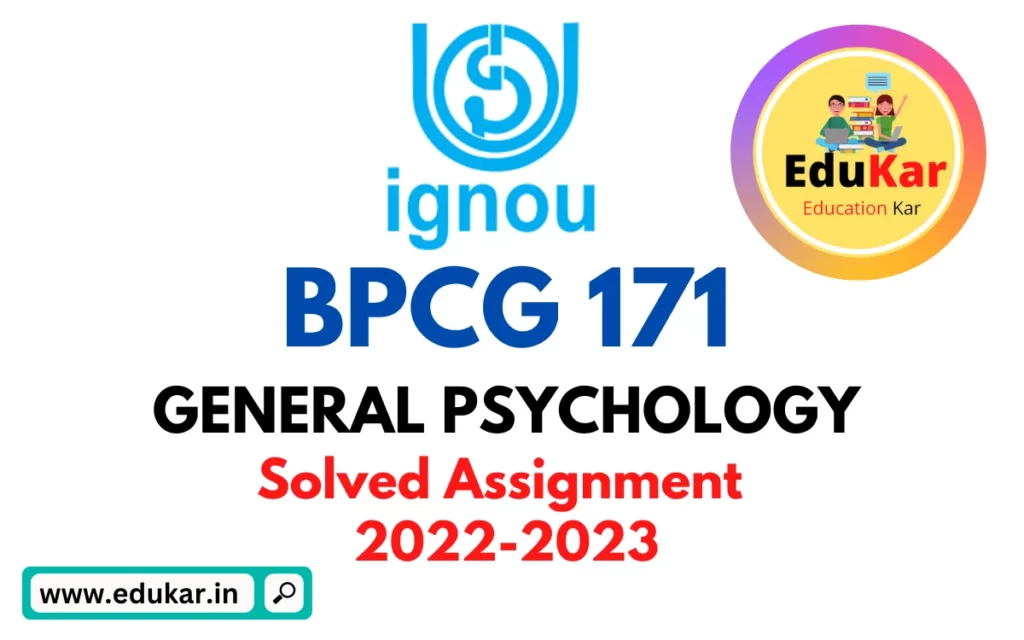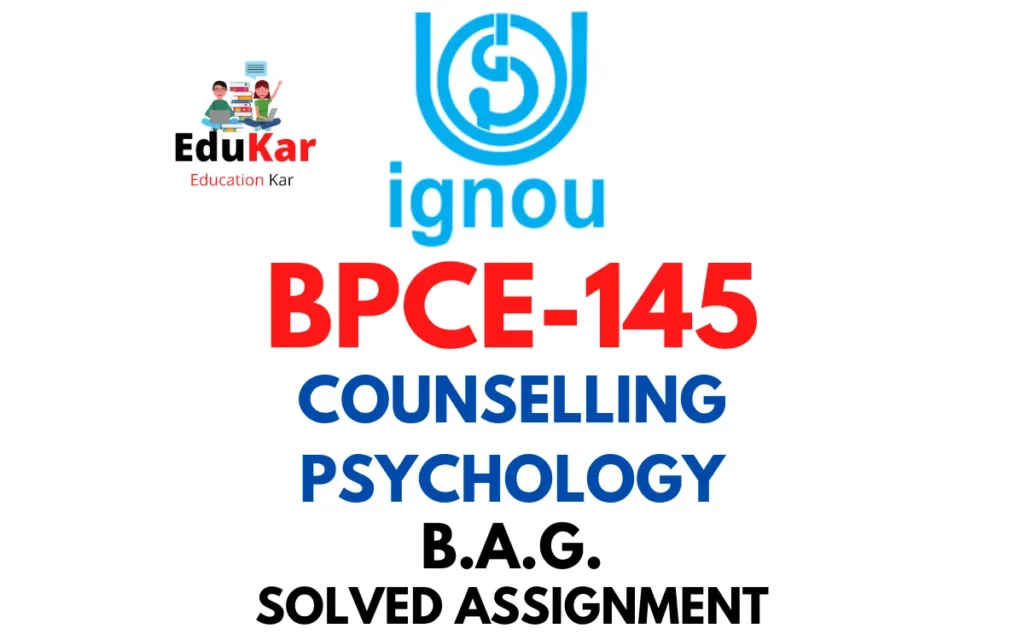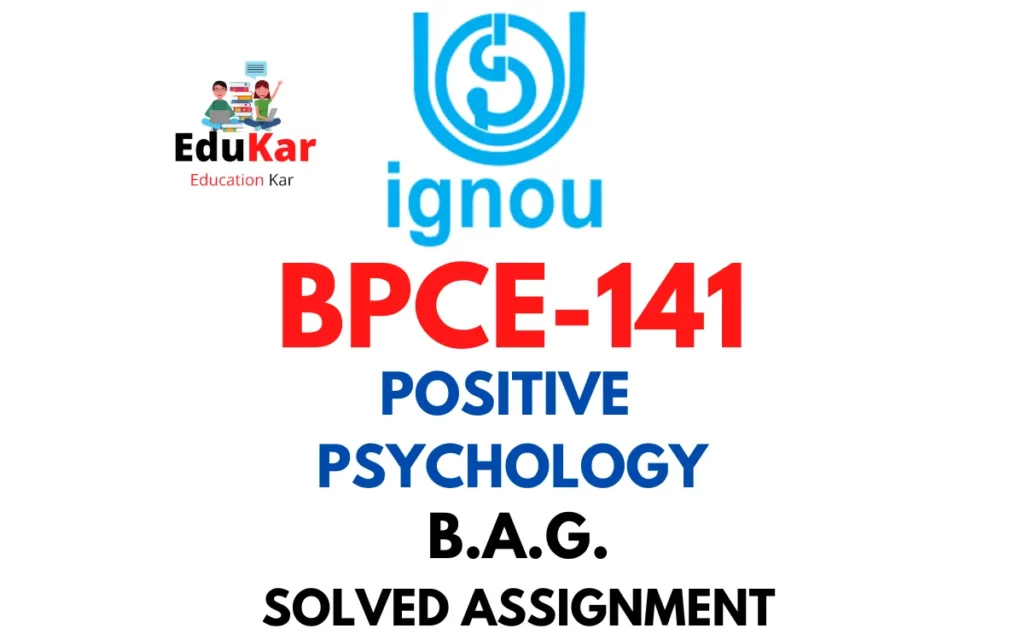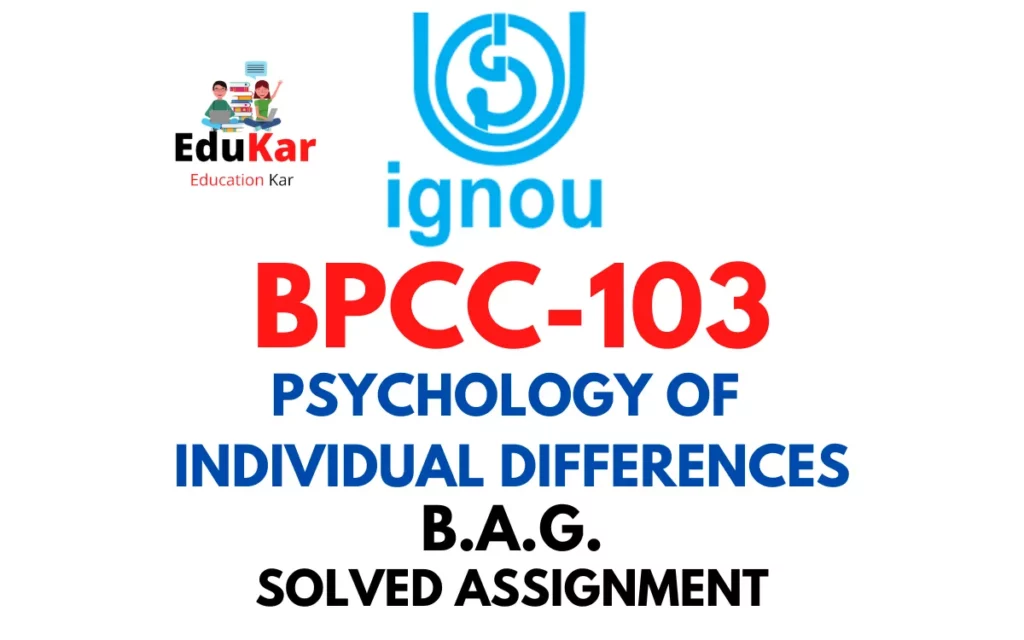Contents
- 1 Assignment One
- 2 Answer the following descriptive category questions in about 500 words each. Each question carries 20 marks.
- 3 1. What is identity? Discuss the socio structural factors influencing identity development.
- 4 2. Explain intrinsic and extrinsic motivation. Describe ways to enhance both types of motivation.
- 5 Assignment Two
- 6 Answer the following middle category questions in about 250 words each. Each question carries 10 marks.
- 7 3. Describe the steps and techniques in modifying dysfunctional attitudes.
- 8 4. Describe the types of mood disorders.
- 9 5.Explain the concept of emotional intelligence and its components.
- 10 Assignment Three
- 11 Answer the following short category questions in about 100 words each. Each question carries 6 marks.
- 12 6. Psychosomatic and Somato-psychological factors
- 13 7. Varieties of self
- 14 8. Motivational interviewing
- 15 9. Aspects of mindfulness
- 16 10. Key attributes of positive youth development
Get the most comprehensive and accurate solutions to the questions in IGNOU BPCG 175 course with our solved assignment. Prepared by experienced professionals, aligned with the latest syllabus and guidelines set by IGNOU. Achieve academic excellence effortlessly.

| Title | IGNOU- BPCG 175 Solved Assignment 2022-2023 (PSYCHOLOGY FOR LIVING) |
| University | IGNOU |
| Degree | Bachelor Degree Programme |
| Course Code | BPCG 175 |
| Course Name | PSYCHOLOGY FOR LIVING |
| Programme Name | Bachelor of Arts (General) |
| Programme Code | BAG |
| Total Marks | 100 |
| Year | 2022-2023 |
| Language | English |
| Assignment Code | Asst /TMA /2022-23 |
| Last Date for Submission of Assignment: | For June Examination: 31st March For December Examination: 30th September |
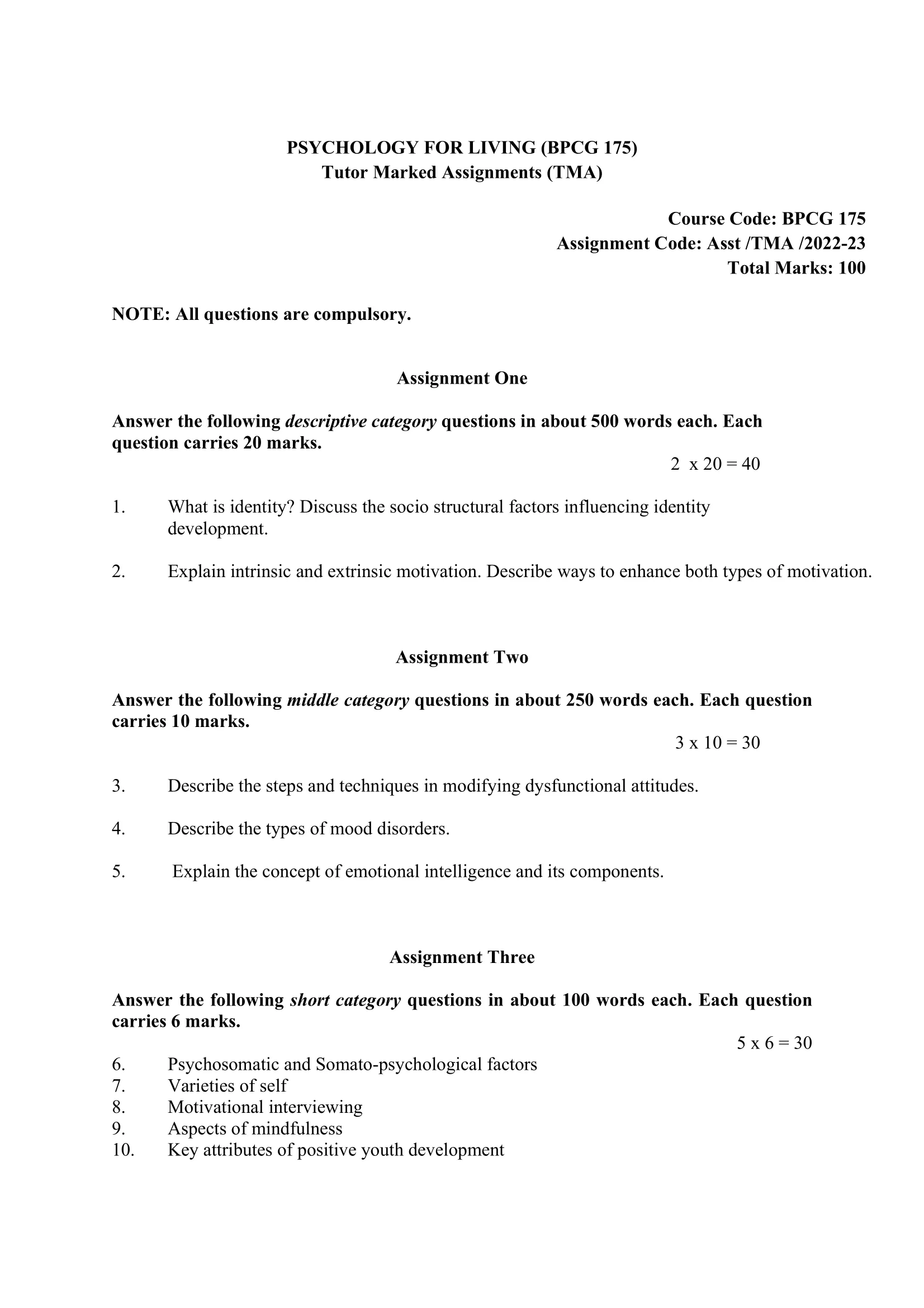
Assignment One
Answer the following descriptive category questions in about 500 words each. Each question carries 20 marks.
1. What is identity? Discuss the socio structural factors influencing identity development.
Ans: Identity refers to the qualities, beliefs, personality, appearance and expressions that make a person unique and distinguish them from others. It encompasses an individual’s self-image, social roles and relationships, cultural affiliations, and life experiences. The development of identity is a complex and ongoing process that is influenced by a variety of socio-structural factors.
Culture plays a significant role in shaping identity, as it provides individuals with a shared set of beliefs, values, norms, and expectations. Culture also provides a sense of belonging, community and can shape an individual’s self-concept. For example, one’s cultural background can influence their beliefs about gender roles, familial relationships, and personal values.
Family is another key factor that shapes identity. Family relationships, interactions and dynamics can impact the development of an individual’s self-concept and values. Family can also provide a sense of security and stability, and play a crucial role in shaping an individual’s sense of belonging and self-worth.
Peer relationships and social networks are also important factors in identity development. Peer relationships often involve a mutual exchange of ideas, values, and beliefs, and can shape an individual’s self-concept, attitudes, and beliefs. Social networks can also help individuals form a sense of belonging, increase their self-esteem, and provide opportunities for personal growth and development.
Education is also a crucial factor in shaping identity, as it provides individuals with knowledge, skills, and values that are necessary for personal and professional development. The education system is also responsible for transmitting cultural and societal norms, beliefs and values.
Economic status, race, and gender can also play a significant role in shaping identity. These factors can impact an individual’s life opportunities and experiences, and can shape their beliefs, values, and self-image. For example, an individual’s economic status can influence their education, health and well-being, and overall quality of life.
2. Explain intrinsic and extrinsic motivation. Describe ways to enhance both types of motivation.
Ans: Intrinsic motivation and extrinsic motivation are two different types of motivation that drive human behavior. Intrinsic motivation is an internal drive to engage in an activity for its own sake, while extrinsic motivation refers to doing something in order to attain a specific external reward or to avoid punishment.
Intrinsic motivation is often considered the most powerful form of motivation, as it stems from an individual’s innate enjoyment of a task, curiosity, or interest in a particular subject. Intrinsic motivation is typically associated with a greater sense of satisfaction and engagement, as individuals are more likely to continue pursuing a task because they enjoy it, rather than because of an external reward.
Extrinsic motivation, on the other hand, is driven by external factors such as rewards or punishments. Extrinsic motivation can be further broken down into four categories: material rewards, such as money or prizes; social rewards, such as recognition or approval from others; egoistic rewards, such as a sense of achievement or personal accomplishment; and avoidance rewards, such as avoiding a negative outcome or punishment.
To enhance intrinsic motivation, individuals can engage in activities that align with their interests and values, and seek out opportunities for personal growth and self-expression. Additionally, setting personal goals and providing regular feedback can help to sustain intrinsic motivation, as individuals can see the progress they are making and feel a sense of accomplishment.
To enhance extrinsic motivation, it is important to provide meaningful and relevant rewards that align with the individual’s interests and values. Additionally, clear communication of expectations and goals can help to increase extrinsic motivation, as individuals are more likely to work towards a specific outcome if they understand what is expected of them.
Another effective way to enhance extrinsic motivation is to provide regular feedback and recognition for effort and achievement. This can help individuals feel valued and appreciated, and can increase their sense of pride and accomplishment. It is also important to create a supportive and inclusive environment that fosters a sense of belonging and community, as this can enhance extrinsic motivation by providing individuals with a sense of social support and encouragement.
Assignment Two
Answer the following middle category questions in about 250 words each. Each question carries 10 marks.
3. Describe the steps and techniques in modifying dysfunctional attitudes.
Ans: Modifying dysfunctional attitudes involves changing negative thought patterns that contribute to psychological distress and affective disorders. The following steps and techniques can help in this process:
- Awareness: The first step is to become aware of your negative thought patterns and the beliefs that underlie them. This can be done through journaling or working with a therapist.
- Identifying cognitive distortions: Common cognitive distortions include all-or-nothing thinking, overgeneralization, and mental filtering. By recognizing these thought patterns, individuals can start to challenge and change them.
- Reframing: Reframing involves looking at a situation from a different perspective. For example, instead of viewing a failure as a personal deficiency, one can see it as a learning opportunity.
- Evidence collection: Collecting evidence to challenge negative thoughts can help to weaken their grip. This might involve making a list of instances when things turned out better than expected, or when negative thoughts were not accurate.
- Cognitive restructuring: This technique involves changing negative thought patterns by finding more balanced and accurate alternatives. For example, instead of thinking “I can’t handle this,” one might say, “I’ve handled tough situations before and I’ll figure this out too.”
- Practice: Finally, it’s important to practice new ways of thinking. This can involve repeating positive affirmations, focusing on one’s strengths, and intentionally looking for the positive in everyday life.
4. Describe the types of mood disorders.
Ans: Mood disorders are a group of mental health conditions characterized by persistent feelings of sadness, anxiety, or irritability. There are several different types of mood disorders, including:
- Major Depressive Disorder: Also known as clinical depression, this is characterized by persistent feelings of sadness, hopelessness, and loss of interest in activities.
- Bipolar Disorder: This is a condition in which an individual experiences alternating periods of mania (abnormally elevated or irritable mood) and depression.
- Dysthymic Disorder: This is a type of chronic low-grade depression that lasts for at least two years. It is characterized by persistent feelings of sadness and low energy, as well as difficulties with sleep and appetite.
- Cyclothymic Disorder: This is a type of bipolar disorder characterized by milder swings between periods of hypomania (elevated mood) and depression.
- Seasonal Affective Disorder (SAD): This is a type of depression that occurs in a seasonal pattern, typically in the fall and winter months, when there is less natural light.
- Premenstrual Dysphoric Disorder (PMDD): This is a severe form of premenstrual syndrome (PMS) characterized by mood swings, irritability, and depression that occur in the week or two before menstruation.
- Substance/Medication-Induced Mood Disorder: This type of mood disorder is caused by the use of certain substances (such as alcohol, drugs, or medication) or the discontinuation of certain medications.
It’s important to seek professional help if you are experiencing persistent feelings of sadness, anxiety, or irritability, as these symptoms can be a sign of a mood disorder. Treatment options include therapy, medication, and lifestyle changes. With appropriate care and support, individuals with mood disorders can learn to manage their symptoms and improve their quality of life.
5.Explain the concept of emotional intelligence and its components.
Ans: Emotional intelligence is the ability to understand and manage one’s own emotions and the emotions of others. It involves recognizing, understanding, and using emotions in a productive way. The concept of emotional intelligence was first introduced by psychologist and scientist Peter Salovey and psychologist John Mayer in 1990.
There are four components of emotional intelligence:
- Self-awareness: This involves the ability to recognize one’s own emotions, as well as their impact on thoughts and behaviors. It also involves being aware of one’s strengths and limitations.
- Self-regulation: This involves the ability to manage and control one’s own emotions, thoughts, and behaviors. It involves techniques such as problem-solving, stress management, and impulse control.
- Motivation: This involves the ability to use emotions to drive behavior and achieve goals. People with high emotional intelligence are able to use their emotions to motivate themselves and others.
- Empathy: This involves the ability to understand and share the emotions of others. People with high emotional intelligence are able to put themselves in other people’s shoes, and understand how they are feeling.
Research has shown that individuals with high emotional intelligence are more likely to be successful in their personal and professional lives. They are better able to form and maintain positive relationships, deal with conflict, and adapt to change. On the other hand, people with low emotional intelligence may struggle with these skills, which can lead to difficulties in their personal and professional lives.
Assignment Three
Answer the following short category questions in about 100 words each. Each question carries 6 marks.
6. Psychosomatic and Somato-psychological factors
Ans: Psychosomatic and somato-psychological factors refer to the interplay between psychological and physical processes that can impact health and well-being. Psychosomatic factors refer to the psychological factors that contribute to physical symptoms or illness, such as stress, anxiety, and depression. Somato-psychological factors refer to the physical factors that contribute to psychological distress, such as pain, injury, or illness. Both psychosomatic and somato-psychological factors are important to consider when assessing health and well-being, as they can have a significant impact on an individual’s quality of life and overall functioning. Understanding these factors and how they interact with one another can be crucial in developing effective treatment and management strategies for individuals experiencing physical or psychological distress.
7. Varieties of self
Ans: The concept of the “self” refers to one’s sense of identity, personality, and individuality. There are several varieties of the self that have been identified in the field of psychology, including the personal self, the social self, the collective self, and the spiritual self.
The personal self refers to one’s individual sense of self and includes elements such as personality traits, attitudes, beliefs, and personal values. The social self refers to the self as it is perceived and defined in relation to others, and is shaped by social norms and cultural expectations. The collective self refers to one’s sense of belonging to a particular group or community, and is influenced by shared experiences and group identities. The spiritual self refers to one’s sense of connection to a higher power or purpose beyond the individual self.
Each of these varieties of the self can play a different role in shaping an individual’s overall sense of identity and well-being, and can interact with one another in complex and dynamic ways. Understanding these different varieties of the self can provide insight into the complex nature of human identity and personality.
8. Motivational interviewing
Ans: Motivational Interviewing (MI) is a client-centered counseling approach that aims to help individuals explore and resolve ambivalence about change. MI is based on the principles of motivational psychology and is used to address a wide range of behavioral and mental health issues, such as substance abuse, eating disorders, and other addictive behaviors.
MI is characterized by its focus on the client’s own motivation for change, rather than imposing change from the outside. The counselor uses active listening, open-ended questions, and reflective statements to help the client identify their own reasons for change and to build momentum for that change.
MI has been shown to be effective in helping individuals to overcome resistance to change and to increase their engagement in treatment and other therapeutic interventions. It is also a non-confrontational approach, which can help to build rapport and trust between the counselor and the client, and can enhance the likelihood of success in treatment.
9. Aspects of mindfulness
Ans: Mindfulness is the act of paying attention to present-moment experiences with curiosity, openness, and acceptance. It involves being aware of thoughts, emotions, and sensations as they arise, without judgment. There are several aspects of mindfulness that are important to consider in its practice and application, including:
- Attention: The ability to focus one’s attention on the present moment.
- Curiosity: A willingness to explore experiences without judgment.
- Acceptance: A non-judgmental approach to experiences, both positive and negative.
- Presence: The ability to be fully present in the moment, rather than dwelling on the past or worrying about the future.
- Self-awareness: The ability to understand one’s own thoughts, emotions, and sensations, and how they impact behavior.
- Regulation: The ability to regulate one’s own responses to experiences, rather than reacting automatically.
The practice of mindfulness can have numerous benefits for physical and mental health, including reducing stress and anxiety, improving mood, and enhancing cognitive functioning. By developing mindfulness, individuals can learn to approach life experiences with greater awareness, presence, and self-regulation.
10. Key attributes of positive youth development
Ans: Positive Youth Development (PYD) is a strengths-based approach to supporting the healthy development of young people. Key attributes of PYD include:
- Positive Relationships: Building supportive relationships with adults, peers, and the community.
- Positive Identity: Developing a positive sense of self, including a strong sense of self-esteem and self-worth.
- Competence: Building skills and abilities, and a sense of mastery and achievement.
- Positive Values: Developing a sense of ethics and moral responsibility, and embracing positive values such as respect, responsibility, and caring.
- Positive Purpose: Having a sense of direction, purpose, and meaning in life, and feeling engaged and connected to one’s community and the world.
By focusing on these key attributes, PYD programs aim to foster the holistic development of young people, helping them to become healthy, happy, and well-adjusted adults. PYD programs often involve a combination of individual, family, community, and school-based activities and interventions, and may include mentorship, skill-building, leadership opportunities, and service-learning. By investing in positive youth development, communities can support the healthy growth and development of their young people and lay the foundation for a bright future.
How to Download BPCG 175 Solved Assignment?
You can download it from the www.edukar.in, they have a big database for all the IGNOU solved assignments.
Is the BPCG 175 Solved Assignment Free?
Yes this is absolutely free to download the solved assignment from www.edukar.in
What is the last submission date for BPCG 175 Assignment?
For June Examination: 31st March, For December Examination: 30th September

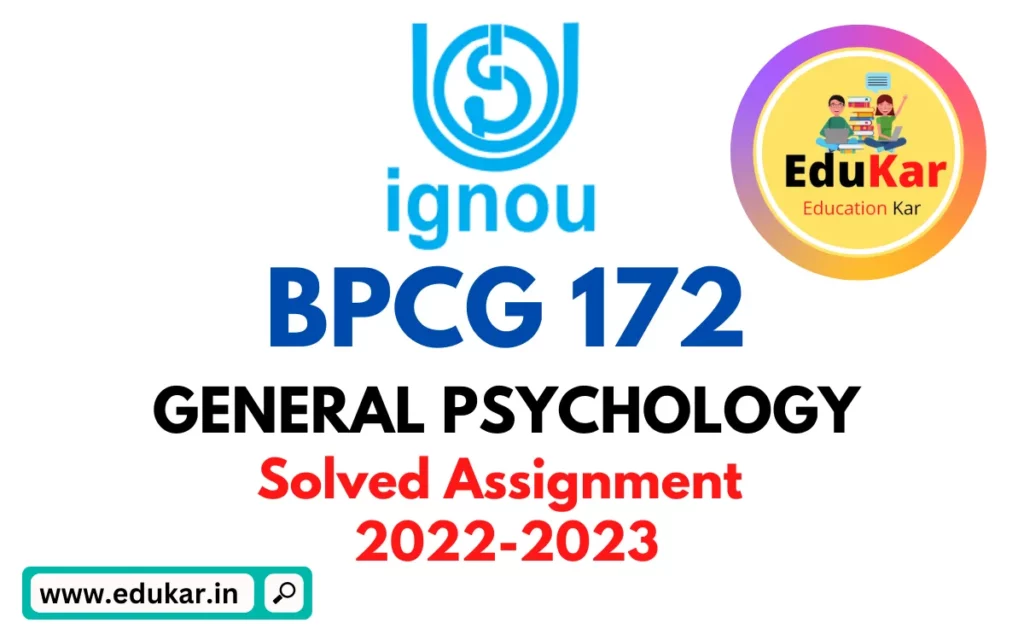

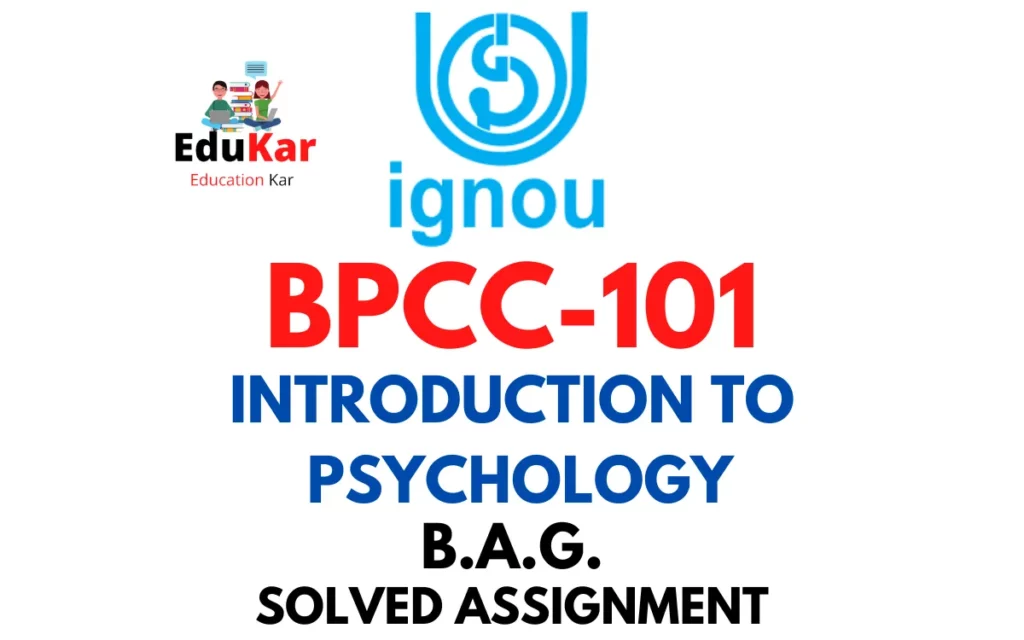

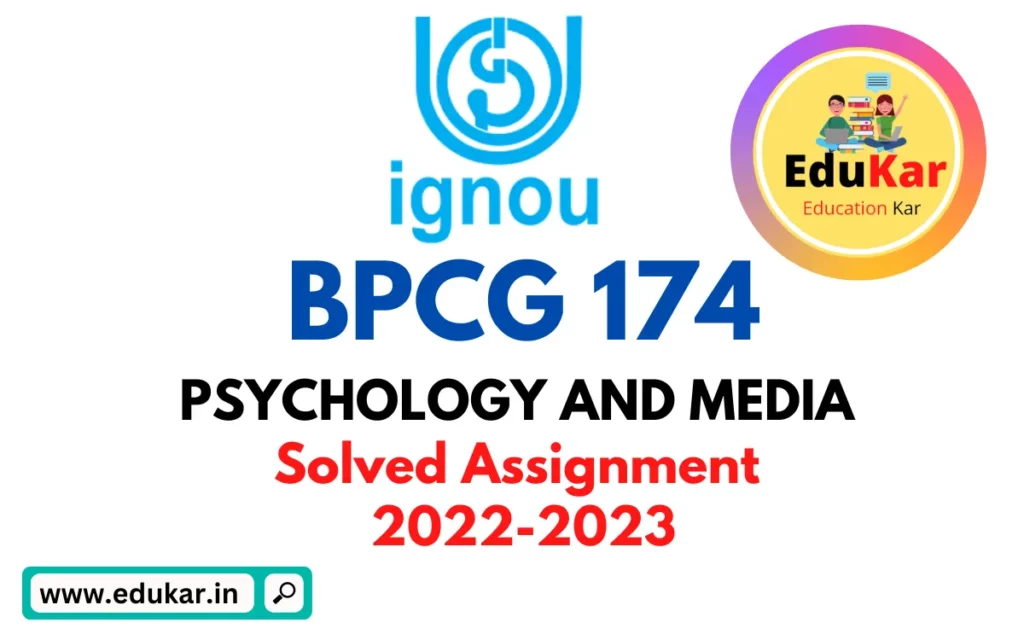
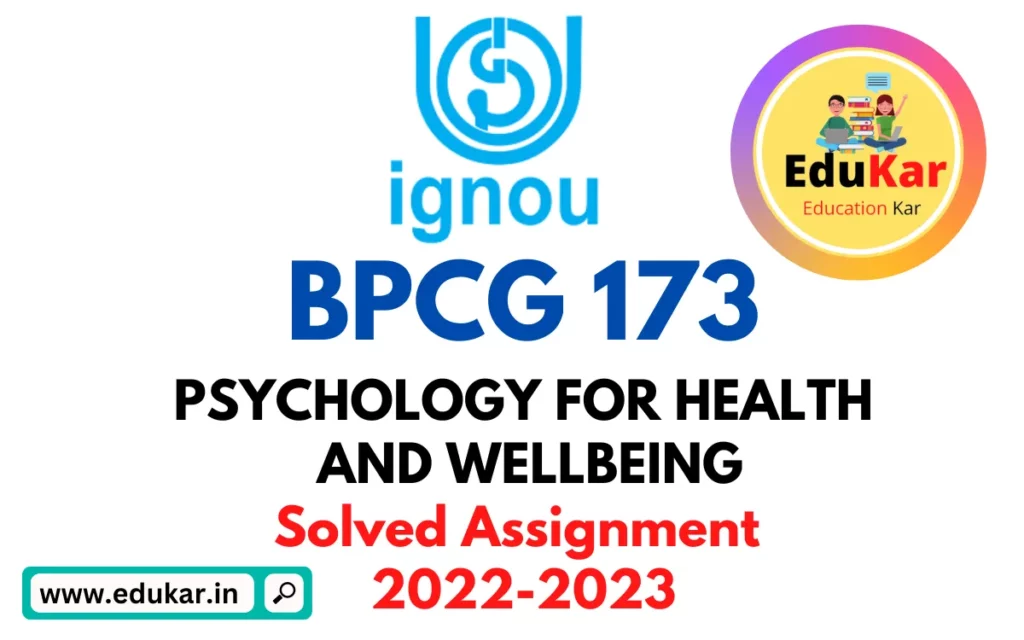
![[Solved Assignment] BPCS 188-APPLICATIONS OF SOCIAL PSYCHOLOGY (IGNOU-BAG) 2022-2023 BPCS 188-APPLICATIONS OF SOCIAL PSYCHOLOGY IGNOU BAG Solved Assignment 2022-2023](https://edukar.in/wp-content/uploads/2023/01/BPCS-188-APPLICATIONS-OF-SOCIAL-PSYCHOLOGY-IGNOU-BAG-Solved-Assignment-2022-2023-1024x640.webp)


